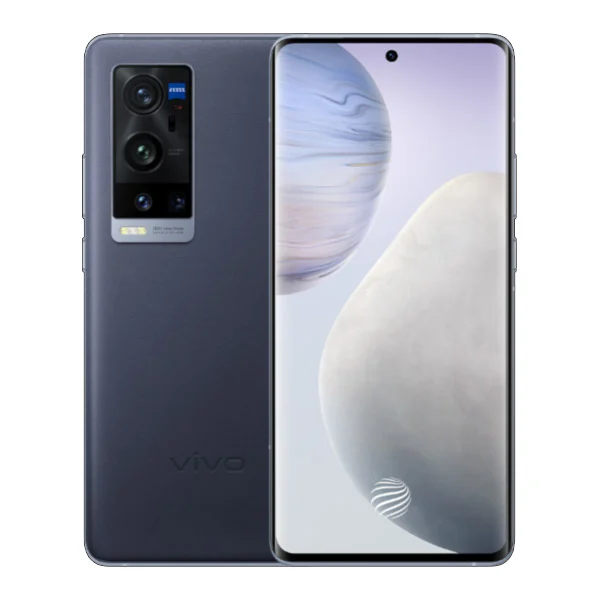Table of Contents
Vivo X60 Pro Plus 5G
The total ranking is based on our editors’ evaluation.
-
Design 10 / 10
-
Display 10 / 10
-
Camera 10 / 10
-
Features 9 / 10
-
Connectivity 9 / 10
-
Usability 9 / 10
-
Performance 10 / 10
-
Battery 9 / 10
The Vivo X60 Pro Plus 5G was unveiled on January 21, 2021.
The smartphone is 158.6 x 73.4 x 9.1 mm in size and weighs 190.6 grams. It has a display resolution of 1080 x 2376 pixels and supports Dual SIM (Nano-SIM, dual stand-by).
It has 8 GB and 12 GB of RAM, as well as 128 GB and 256 GB of internal storage. The Qualcomm SM8350 Snapdragon 888 Octa-core CPU powers the phone. The Vivo X60 Pro is powered by Android 11 and OriginOS 1.0.
It has a non-removable Li-Po 4200 mAh battery with fast charging capability of 55W. The smartphone comes in two colors: orange and dark blue. Fingerprint (under display, optical), accelerometer, gyro, proximity, compass, and color spectrum sensors are all built into the smartphone.
The smartphone has four cameras: 50 megapixels (wide) + 8 megapixels (periscope telephoto) with 5x optical zoom + 32 megapixels (telephoto) + 48 megapixels (telephoto) (ultrawide). On the front, there is a single 32-megapixel camera (wide).
Vivo X60 Pro Plus 5G – SPECIFICATIONS
General
-
ModelVivo X60 Pro Plus 5G
-
ReleasedJanuary, 2021
-
StatusAvailable
Design
Design Type: The size, shape, and appearance of a mobile phone, as well as the arrangement and placement of essential components, are referred to as form factor. In mobile phones, there are three major form factors: bar phones, folding phones, and sliding phones.
-
Dimensions158.6 x 73.4 x 9.1 mm
-
Weight190.6 Grams
-
WaterproofNo
Display
Display Type Display Technology: TFT (Thin Film Transistor), IPS (In-Place Switching), OLED (Organic Light Emitting Diode), AMOLED (Active-Matrix Organic Light-Emitting Diode), Super AMOLED (an even more advanced version of AMOLED), Resistive Touchscreen (Resistive touchscreens contain two layers of conductive material with a very small gap between them that acts as a resistor) are some of the display technologies and types (Capacitive touchscreen technology consists of a layer of glass coated with a transparent conductor)
-
Size6.56 inches
-
Resolution1080 x 2376 pixels
Display Colors: The number of various shades of color that the screen can display => 64K colors, 256K colors, and 16 million colors. Obviously, 16M is the maximum accessible range of colors and is superior than the others.
16M
Pixel Density: is the pixel density on a given display, measured in pixels per inch (ppi). Pixel density is determined by dividing a display’s diagonal pixel resolution by its diagonal dimension; the higher the pixel density, the better the display quality.
PPI = 398 (pixels per inch)
-
Touch ScreenYes
Hardware
-
CPU The main chipset of the device.Octa-core (1×2.84 GHz Kryo 680 + 3×2.42 GHz Kryo 680 + 4×1.80 GHz Kryo 680
- GPU (Graphics Processing Unit) is a single-chip processor that manipulates and alters memory quickly to speed up the production of images in a frame buffer for output to a display. This includes lighting effects, object transformations, and 3D motion.
660 Adreno - RAM (Memory) (Random Access Memory) is a sort of computer memory that allows information to be stored and accessed fast from random locations. Any byte of memory can be accessed without touching the bytes before it. The most prevalent type of memory in computers, smartphones, tablets, and other electronic devices is RAM.
12 GB, 8 GB - Internal Storage is a data storage space (flash memory) that is commonly found in smartphones, tablets, and other electronic devices, and is used to store the operating system, apps, music, images, videos, files, and other user data.
256 GB, 128 GB - Memory Card Slot A Memory Card Slot is a specific slot that allows you to insert a memory card into your computer. You can use memory cards to expand the phone’s built-in memory. A memory card (also known as a flash memory card or a storage card) is a compact storage medium for storing data such as text, photos, audio, and video on small, portable, or remote computing devices such as mobile phones, mp3 players, and digital cameras.
No - Sensors: are electronic components that detect and respond to information from the physical world in some way. Light, heat, motion, moisture, pressure, and location are examples of specific inputs. A location sensor, such as a GPS receiver, may determine the present location of your electronic device, and the output is usually a signal that is converted for use in computing systems.
Accelerometer, gyro, proximity, compass, color spectrum, fingerprint (under display, optical)
Camera
- Rear Camera: is capable of taking photos and, in most cases, movies, The resolution (measured in megapixels) and lens focus type (fixed or automated) are the most essential qualities of a camera. Higher megapixel cameras are known to capture higher quality images, however this is not necessarily an accurate indication of the photos quality.
50 megapixels (wide) Plus 8 megapixels (periscope telephoto) 48 MP + 5x optical zoom + 32 MP (telephoto) (ultrawide) -
Image3240p
-
Video8K@30fps, 4K@30/60fps, 1080p@30/60fps, gyro-EIS, HDR10+
- Flash Light: In most camera mobile phones, there are two types of flash lights: LED Flash (LED flash uses less energy and takes up less space than other light sources; LEDs may be strobed quicker than any other light source), Xenon Flash (xenon flash produces an extremely intense full-spectrum white light for a very short duration)
HDR, panoramic, Zeiss optics, dual-LED dual-tone flash, Zeiss optics -
Front Camera32 MP (wide)
Battery
-
Capacity Battery CapacityLi-Po 4200 mAh + Fast charging 55W
-
PlacementNon-removable
